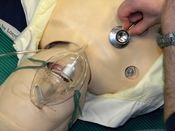The disease chronic bronchitis is defined in clinical terms as a condition
in which a chronic productive cough is present at least three months per year for
at least two consecutive years (Egans p. 140). The definition also includes there
is no other known cause for the cough. Chronic bronchitis can occur without
airflow obstruction. However, signs and symptoms usually only become
significant when there is an obstruction.
Chronic bronchitis is more prevalent among heavy smokers.
The most common sign of chronic bronchitis would be the chronic phlegm
producing cough. Chronic bronchitis patients with airflow obstructions
will sometimes exhibit dyspnea on excertion, and the patient will likely have
decrerased airflow due to bronchiospasms.
When diagnosing chronic bronchitis test results will show normal lung
volumes, diffusion capacity, and static lung compliance. On the other hand a
simple arteial blood gas will show a decresaed PAO2 and an increased
PaCO2 meaning a decrease in gas exchange.
The patients chest x-ray
would also show "dirty lungs" with peribronchial cuffing which suggest
thickened bronchial walls.
When treating chronic bronchitis patients with airflow obstruction it
is important to determine what is causing the obstruction (bronchiospasms,
mucous plugging or both) and provide the best therapy for your patient
for this paper I will be teating a patient with retained secretions as well as
acute bronchiospasms.
Bronchodilater therapy would be benificial in treating the patients
bronchospasms. The patient can be given this therapy at home or in the
hospital as needed via MDI or SVN assuming the patient is able follow
directions a MDI with spacer would be the best option. It is important to monitor
heart and respiritory rates, blood pressure, and breath sounds before, during,
and after treatment to ensure there are no adverse effects. To monitor a
patients progress using this therapy pre and...


